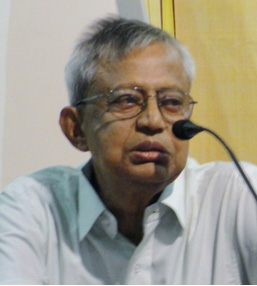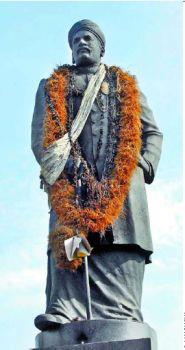Manohar Mouli Biswas
(First published in World Prout Assembly site in August 2007)
Dalits are perhaps by their birth communist in nature. They are born in the graded inequality of the society and as a result what happens they have to face the lot of sufferings in their daily life. They are by birth poor, illiterate and landless labours of the soil. These toiling masses very easily become followers of the communist party and they sometimes become the active members also. While they become active members they have to undergo certain limitations. What are those limitations? They are used to actively work amongst the Dalits and Adibasis. Dalits are used to convince and persuade more and more Dalits and Adibasis. The people at home and abroad may know this fact that the Indian communists did not any time talk of the Cultural Revolution in India. Why? The answer of this question is very simple. The socialism, if anytime it is planned to be set up in the caste-divided society of graded inequality like India, needs the pre-occurrence of the Cultural Revolution and this Cultural Revolution should have the single point agenda. What is this agenda of the pre-occurrence? It is nothing but the annihilation of the caste system of the society for which Dr. Ambedkar advocated to the modernizers of the society.

After thirty years of leftists’ rule in West Bengal the inequality has vigorously been sharpened in the field of economy, education and health-care. It is seen to vigorously increase in the field employment opportunities in particular. Are not all these against the ideology of communism? Who cares for? History speaks that the thought of communism was brought into India by Mr. M. N. Roy and his other associates who mostly all were Brahmins and at that time living in Russia. From the initial stage of its spread in India and very particularly in West Bengal it is seen to be in the hands of the Brahmins as leaders and the total control is, by hook or by crook, maintained by the social hierarchy. In West Bengal while the history repeats the same path resultantly whatever the benefits have come in West Bengal out of the land-reforms, reforms of education, reforms of health-cares, job-opportunities etc. have gone of its larger shares to the social hierarchies. Whatever the shares the Dalits and the religious minorities have got are very less in comparison to their population and definitely in violation of their constitutional rights.
1.Dalit Mass Massacre In Marichjhanpi
The people who were living in the Marichjhanpi area, a part of the non-farming Sundarbans were exclusively from the Dalit communities and very particularly they were the Namasudras of East Bengal. What happened there? The Namasudras were the major community in East Pakistan at the time of partition of Bengal and they had come to West Bengal as a flux of refugees. At that time the communist party was undivided and they stood by the side of those refugees. They set up their mass organization amongst them. It was a long journey the Dalit refugees traveled through their sufferings in homeless, shelter-less and foodless condition in different parts of Bengal as well as in India. As soon as the Marxist Communist Party became the ruling power in 1977 with their vast majority in the Assembly these homeless and shelter-less people started to live in the Marichjhanpi-Sundarbans. They started to convert the unproductive lands into the productivity using their unlimited toiling capability. Some of the people started to live on fishing in a number of rivers of those areas. Mr. Jyoti Basu was the then chief minister of West Bengal. The government immediately became unkind to the Dalits and ordered the police force to evacuate the dalit-occupancy from Marichjhanpi. What happened then? The Dalits were forced to leave the place. And perhaps it is the black day in the history of Dalits in West Bengal that 36 people of dalits lost their lives en-masse by police firing on the 31st January, two years after the Marxist came into power.

2. Land Reformation
The Marxist Communist Party has earned a lot of fame due to execution of the land reformation which is much hyped as ‘Operation Barga’ in West Bengal. What was the pro-gram of land reformation? How much did it help the Dalits and Adibasis? What is here the moot- question to be analyzed ? The history, as it is known, is that Pt. Nehru initiated the Zamindary Abolition in 1948. But the land, surplus in kind, remained under their control in different vested manners. The government seized the surplus land and distributed amongst the landless labourers. It was in 1977 while Mr. Jyoti Basu, the Chief Minister of the government had continued the same position at a stretch for 23 years, unchallenged by anyone in the Left Front till he quits the post of his own accord. The landless agricultural labourers in West Bengal in 1971 were 42.57, 48.85 and 19.45 percent respectively from the SC, ST and Non-SC-ST groups of people; whereas it figured in all India level in the same year as 51.75, 33.04 and 20.20 percent respectively. After the Operation Barga in West Bengal in 1991 these landless agricultural labourers were 41.12, 50.70 and 15.55 percent from SC, ST and Non-SC-ST group of people respectively. It is seen from the data above that volume of landless agricultural labourers has enormously increased after the land reformation amongst the Adibasis and benefits have gone in sizeable quantity to the upper castes of West Bengal. On the other hand the Dalits are seen to be benefited little.
3. Education Reformation
Dalits in West Bengal have become the worst victims due to reformation of education in the state. In the primary stage of education in all the Bengali medium schools where the Dalit and Adibasi children normally take their education had been stopped of teaching English language and this reformation was made by the Left Front with a view to increase the percentage of literacy to an extent whatever is possible in the state. What was the result of exercising this policy? It helped in achieving the target to a small extent but it had seriously damaged the future career of the Dalit children. They become to realize the matter as and when they tried to push themselves into the field of their higher education. Primary schools without English learning are generally meant for the poor and side by side English medium schools with higher tuition fees were run for the children of the rich. Illiteracy is one curse and the blockage in higher education was imposed upon the Dalits as if a bigger curse on them under the left regime. Another circular from the Ministry of Higher Education was once given to all colleges in the state for screening the admission of SC-ST category students that they should get admission to the UG-Honours or PG-courses on conditions if they are having secured minimum 90 percent marks on aggregate of the unreserved category students. As a result what happened not a single student of reserve category could have their admission in a number of reputed colleges in Kolkata.
4. Reformation of Health-Care
The Government Hospitals by and large provide near about hundred percent of the health-cares to the Dalits in the state. At present the efficiency of treatment in the Govt. Hospital has gone to the poorest level. Anyone desiring satisfactory health-care is to depend on the private doctors or private hospitals.
Since the charges of treatment in the private hospital is exorbitantly high and the deposit prior to admission needs minimum rupees ten thousands or more, it is now beyond doubt that the Dalits do not find any space of their treatment in the private capacity. Dalits are very often found to die of mal-nutrition and without proper treatment. In the tea-gardens of different places in North Bengal a few hundreds of the tribal people have died of the starvation just after the tea-gardens have been locked out. In a span of thirteen months in a particular tea-garden the death of 142 people occurred for scarcity of food only. In the NSSO (national sample survey organization) report published in February, 2007 it is seen that West Bengal is ahead of all the states in respect of the poor performance to provide full meal at least once a day through the month of the year. What the Bengal media generally do? They are very habitual to point out the weak points of the other states and very glamorously depict the starvation death of Kalanhandi in Orissa. The above report mentions that 10.6 percent of the rural people of Bengal suffer from the food scarcity whereas it is 4.8 percent in case of Kalanhandi which stands second in the national gradation.
5. Deprivation in Reservation Policy
The reservation policy for SCs-STs-OBCs in respect of their children for getting admission into the educational institutions as well as for providing jobs to the educated people of those communities is highly neglected in West Bengal. The Communist parties and particularly the Communists are now in power in West Bengal do not believe in the castes and they believe in the class only. In the name of class whatever the benefits from the Government level they do extend to the proletariat maximum portion of it goes to the proletariats of the upper castes depriving the scheduled castes, scheduled tribes and other backward communities. All these happen in the gross violation of the reservation policies of the constitutional provisions but they don’t care for. A table is shown below ( from report on Staff Census 2000 &2001 / Bureau of Applied Economics & Statistics, Govt. of West Bengal ) to understand the amount of deprivation the SCs-STs do they suffer:
The above table is self explanatory that the percentage of the quota on due remains more or less constant for the successive three years and the quota due for them is not at all a negligible figure which is about 13 % of the total staff strength.
6. Sanjukta Sanrakshan Morcha
Scheduled Castes, Scheduled Tribes, Other Backward Communities and Religious Minorities have joined their hands together to form an united platform to protect the deprivation of scheduled castes, scheduled tribes and other backward communities in respect of their quota they are eligible to enjoy by virtue of the constitutional right. The Muslims of West Bengal are only 3% less than the total population of scheduled castes and scheduled tribes who, by strength, are more than 29.2%. It was big rally of more than fifteen thousand people walked the streets of kolkata and presented their representation to the Governor at Raj Bhawan stating the grievances against the Government. Just after a few months of this incident they made another rally in the similar fashion on 23rd April,2007. from Sealdah Station to Raj Bhawan and gave in writing to Mr. Gopal Krishna Gandhi, the Honorable Governor. At present as it is seen about 1,50,000 reserve posts are still unfilled and a good amount of group ‘D’ posts are also not yet filled up. A very vital question may arise into mind that why the religious minorities and very particularly the muslims had joined hands with the Sanjukta Sanrakshan Morcha? The history behind it is that the muslims in West Bengal enjoy the Government jobs 2% only despite of their population strength is more than the one-fourth of the total. The muslims do not have any quota in the educational institution and it is to be noted also that the OBCs of being the one-fourth of the total population are allowed to enjoy 6-7 % in school level and not anything in the higher level of education.

7. Mass Dalit Killing in Nandigram
Once it was the slogans of the Marxist communists in West Bengal that the “Langal jaar Jami taarâ”. What does this slogan mean? The communists at that time had raised their voice through the party program to put ownership of the agricultural land under the real ploughmen of the society and the real ploughmen who are none but the bottommost layer of the society and particularly the scheduled castes, scheduled tribes and muslims. They started to see a new dream in it. What had happened thereafter? Under the globalization economy the communists have turned their socialist faces to the capitalist faces and they undertook the program to set up the Special Economic Zones (SEZ) at different places. And the Government was unconditionally bowing down heads to the industrialists just to create some jobs of Microsoft Engineering for favor of the unemployment youths of the micro-community people neglecting the interest of the macro-societies of West Bengal. The people coming from the lower strata could clearly foresee that the industrialists are giving their choices to establish their new companies in the areas where the poor cultivators are having small and small holdings producing two-three crops in a year. When the Govt. was acquiring the land at Singur in the district of Hooghly for the Motor Car Company of industrialist of TATA Group the resistance came from the agricultural communities but it was not so strong and well planned as to stop the acquirement. However they could have made so, while the Govt. planned to acquire lands at Nandigram in the district of East Medinipur for making another SEZ to build a Chemical Hub of Salim Group of Indonesia. The police force and the party machinery were on the one side and the peoples’ resistance on the other side. Ultimately it created a government-sponsored genocide on the 14th of March, 2007 where Tublu Samanta, Ratikanta Das, Gobinda Das, Subrata Samanta, Ratan Das, Supriya Jana, Indajul Haq, Satyabala Mondal, Naru Murda, Chanchala Rani Mahata etc of the Dalits, OBCs and Muslims had been killed.
8. Demands for the Appeasement:
From the facts of deprivation the SCs, STs , OBCs and the Muslims of West Bengal made a vigorous appeal to the Govt. of West Bengal through the Governor. The consorted body comprising of the presence of Mr. Santosh Rana, Kazi Safiuddin Ahmed, Dr. Ashis Thakur, Dr. Debashish Majumdar and Manoranjan Mahato, on behalf of the Sanjukta Sanrakshan Morcha demanded that:
(a) The state functionaries responsible for the genocide in Nandigram should be punished and the families of the victims properly compensated.
(b) The SEZ act,2005 should be abrogated.
(c) The quotas for SC/ST in jobs and in higher education ( including medical education) should be filled up.
(d) The West Bengal Government should immediately introduce adequate quotas for OBCs and Muslims in higher education and jobs.
(e) The Central Govt. should take necessary steps to implement reservation for OBCs in IIM, IIT and AIIMS in this academic year and
(f) The government of both central and state should take steps to abrogate the court-imposed ceiling of 50% in the reservation and should introduce reservation in proportion to their share of population both in public and private sector.
9. Dalits of Arts and Literature
Dalits of West Bengal, of course in the fields of art, literature and culture formed an organization as Bangla Dalit Sahitya Sanstha in the year 1992. They were mostly of the BSP-minded, though not having any direct lineage to them. Though not strong enough, yet they have their organization all over West Bengal.
Anytime they find any atrocity or deprivation against the Dalits they raise their voices through writing and organizing mass meeting or seminar. At the time while Chuni Kotal, a Lodha-Tribal girl was studying in M. Sc. Class in Vidyasagar University of West Bengal was virtually forced by the upper caste teachers to commit suicide. She was mentally tortured just like any thing. Someone of the particular upper caste had taken an advantage in the open class very frequently describing her as a girl born of criminal tribe. After her sad demise, the Bangla Dalit Sahitya Sanstha organized a mass movement through different seminars and street corners in broad daylight in the Kolkata mega-city busy street. Their artists performed a number of street- dramas protesting the naked activities of the university teachers. The literary organ of the B.D.S.S. is Chaturtha Dunia published an special issue on Chuni Kotal.

10. Protests of BDSS against Nandigram Mass-Killing
Nandigram is an example of the state-sponsored persecution upon the poor masses of the small agricultural land holders who are against the present SEZ-policy of the government. Under the policy these people are going to lose their paternal land property in the name of industrialization. They know that they are born as illiterate as well as poor. The upper castes are not born on the same plank as they are. Naturally they are aware of the fact that what benefit they will get out of industrialization? They will get nothing but some poorly paid short time-ended jobs of the labor-class only and in lieu of it they will lose permanent labor-field. The government immediately became intolerant and used their state-machinery against those who denied and protested the forcible land seizure. The Bangla Dalit Sahitya Sanstha believes in the democratic norms only their members came forward to observe an evening on 23rd of April, 2007 in the Tripura Hitsadhini Sabha of Kolkata arranging a˜Dalit Kavita Pather Asarâ’. This was nothing but their protest against mass-killing. A number of Dalit poets were present and read out their new composition on this particular issue. The Shantikunja Natya Sanstha staged a small group theatre on the day.
~~~
Manohar Mouli Biswas can be reached at manoharbiswas@yahoo.co.in
Courtesy: [World Prout Assembly, August 2, 2007]
Images courtesy: the net.










